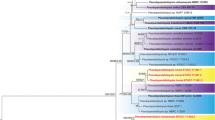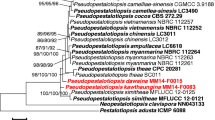Abstract
Pestalotiopsis is a common and important plant-associated pathogen and endophyte with wide geographical and host distribution. In an investigation of endophytic Pestalotiopsis species associated with Podocarpaceae in China, a new species Pestalotiopsis yunnanensis was isolated from Podocarpus macrophyllus in Kunming, southwestern China. This new species produced pycnidium-like conidiamata in culture, distinct from its morphologically similar species, P. funereoides, P. funerea and P. thujae, which produce acervuli in manual media and hosts. P. yunnanensis also possesses a greater conidium length/width ratio, and longer apical and basal appendages as its distinguishing morphology characters. Phylogenetic analysis of internal transcribed spacer (ITS) sequences showed that P. yunnanensis is a member of Pestalotiopsis, and is distinct from morphologically similar P. funereoides, P. funerea, and P. thujae, as well as other Pestalotiopsis species. A dichotomous key to 26 Pestalotiopsis species occurring on Podocarpus plants is also presented.


Similar content being viewed by others

References
Barr ME (1975) Pestalosphaeria, a new genus in the Amphisphaeriaceae. Mycologia 67:187–194
Barr ME (1990) Prodromus to nonlichenized pyrenomycetous members of class Hymenoascomycetes. Mycotaxon 39:43–184
Guba EF (1961) Monograph of Monochaetia and Pestalotia. Harvard University Press, Cambridge
Guo LD, Hyde KD, Liew ECY (2000) Identification of endophytic fungi from Livistona chinensis based on morphology and rDNA sequences. New Phytol 147:617–630
Gure A, Wahisiröm K, Sieniid J (2005) Pathogenicity of seed–associated fungi to Podocarpus falcatus in vitro. For Pathol 35:23–35
Huelsenbeck JP, Ronquist F (2001) MrBayes: Bayesian inference of phylogeny. Bioinformatics 17:754–755
Jeewon R, Liew ECY, Hyde KD (2003) Molecular systematics of the Amphisphaeriaceae based on cladistic analyses of partial LSU rDNA gene sequences. Mycol Res 107:1392–1402
Kirk PM, Cannon PF, Minter DW, Stalpers JA (2008) Dictionary of the fungi, 10th edn. CAB International, Wallingford
Liu AR, Xu T, Guo LD (2007) Molecular and morphological description of Pestalotiopsis hainanensis sp. nov., a new endophyte from a tropical region of China. Fungal Divers 24:23–36
Liu AR, Chen SC, Wu SY, Xu T, Guo LD, Jeewon R, Wei JG (2010) Cultural studies coupled with DNA based sequence analyses and its implication on pigmentation as a phylogenetic marker in Pestalotiopsis taxonomy. Mol Phylogenet Evol 57:528–535
Maharachchikumbura SSN, Guo LD, Chukeatirote E, Bahkali AH, Hyde KD (2011) Pestalotiopsis–morphology, phylogeny, biochemistry and diversity. Fungal Divers 50:167–187
Maharachchikumbura SSN, Guo LD, Cai L, Chukeatirote E, Wu WP, Sun X, Crous PW, Bhat DJ, McKenzie EHC, Bahkali AH, Hyde KD (2012) A multi-locus back bone tree for Pestalotiopsis, with a polyphasic characterization of 14 new species. Fungal Divers. doi:10.1007/s13225-012-0198-1
Metz AM, Haddad A, Worapong J, Long DM, Ford EJ, Hess WM, Strobel GA (2000) Induction of the sexual stage of Pestalotiopsis microspora, a taxol-producing fungus. Microbiology 146:2079–2089
Nag Raj TR (1993) Coelomycetous anamorphs with appendage bearing conidia. Mycologue, Waterloo
Nylander JAA, Olsson U, Alström P, Sanmartín I (2008) Accounting for phylogenetic uncertainty in biogeography: a Bayesian approach to dispersal-vicariance analysis of the thrushes (Aves: Turdus). Syst Biol 57:257–268
Steyaert RL (1949) Contribution a l’etude monographique de Not. et Monochaetia Sacc. (Truncatella gen. nov. et Pestalotiopsis gen. nov.). Bull Jard Bot Brux 19:285–354
Sun XA, Ge QX (1990) Ten new combinations of the genus Pestalotiopsis from China. Acta Agr Univ Zhejiangensis 16(2 suppl):141–150
Sun X, Guo LD (2010) Micronematobotrys, a new genus and its phylogenetic placement based on rDNA sequence analyses. Mycol Prog 9:567–574
Sutton BC (1980) The Coelomycetes. Commonwealth Mycological Institute, Kew
Swofford DL (2002) PAUP*: Phylogenetic analysis using parsimony (*and other methods). Verson 4.0b10. Sinauer, Sunderland
Tejesvi MV, Tamhankar SA, Kini KR, Rao VS, Prakash HS (2009) Phylogenetic analysis of endophytic Pestalotiopsis species from ethnopharmaceutically important medicinal trees. Fungal Divers 38:167–183
Thompson JD, Gibson TJ, Plewniak F, Jeanmougin F, Higgins DG (1997) The ClustalX window interface: Flexible strategies for multiple sequence alignment aided by quality analysis tools. Nucleic Acids Res 24:4876–4882
Watanabe K, Doi Y, Kobayashi T (1998) Conidiomatal development of Pestalotiopsis guepinii and P. neglecta on leaves of Gardenia jasminoides. Mycoscience 39:71–75
Wei G, Chen YX (1994) Further notes on congeners of Pestalotiopsis in China. J Guangxi Agr Univ 13:115–128
Wei JG, Xu T (2004) Pestalotiopsis kunmingensis sp. nov., an endophyte from Podocarpus macrophyllus. Fungal Divers 15:247–254
Wei JG, Xu T, Guo LD, Pan XH (2005) Endophytic Pestalotiopsis species from southern China. Mycosystema 24:481–493
Wei JG, Xu T, Guo LD, Liu AR, Zhang Y, Pan XH (2007) Endophytic Pestalotiopsis species associated with plants of Podocarpaceae, Theaceae and Taxaceae in southern China. Fungal Divers 24:55–74
White TJ, Bruns TD, Lee S, Taylor J (1990) Amplification and direct sequencing of fungal ribosomal DNA genes for phylogenetics. In: Innis MA, Sninsky DH, White TJ (eds) PCR Protocols. Academic, London, pp 315–322
Zhu PL, Ge QX, Xu T (1991) The perfect stage of Pestalotiopsis from China. Mycotaxon 40:129–140
Acknowledgements
This work was supported by the National Natural Science Foundation of China (Nos. 30670012, 30970022, and 31100016), Guangxi Natural Science Foundation (2011GXNSFA018078) and the Plans for Construction of Scientific Topnotch and Innovation Team in Guangxi University. We thank Prof. Jian-Yun Zhuang for revising the Latin description. We are grateful to Dr. Jo Taylor, Royal Botanic Gardens Edinburgh, for revising the manuscript.
Author information
Authors and Affiliations
Corresponding author
Rights and permissions
About this article
Cite this article
Wei, JG., Phan, CK., Wang, L. et al. Pestalotiopsis yunnanensis sp. nov., an endophyte from Podocarpus macrophyllus (Podocarpaceae) based on morphology and ITS sequence data. Mycol Progress 12, 563–568 (2013). https://doi.org/10.1007/s11557-012-0863-5
Received:
Revised:
Accepted:
Published:
Issue Date:
DOI: https://doi.org/10.1007/s11557-012-0863-5



